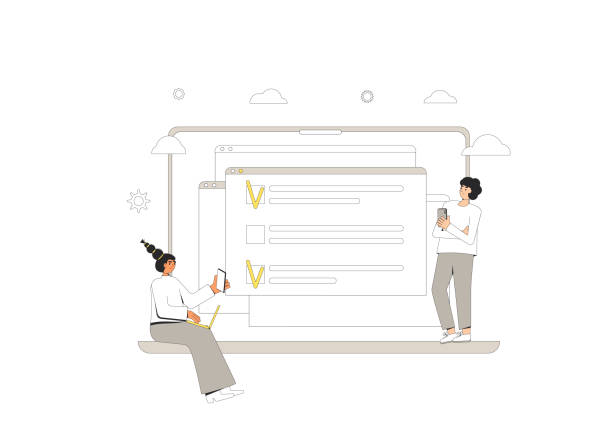Concept and Necessity of Secure Website Design

In the current era, where our daily lives are deeply intertwined with the internet, the concept of #SecureWebsiteDesign has become more important than ever.
A website is not just an online storefront for a business or a platform for sharing information; it is a gateway that can expose sensitive user and organizational data to risk.
Therefore, #WebSecurity is no longer a luxury option, but a vital necessity.
Secure website design refers to a set of measures and protocols implemented throughout all stages of a website’s development and maintenance to protect it against cyberattacks, unauthorized access, and data loss.
This approach includes not only technical aspects such as secure coding and proper server configuration but also human dimensions and organizational procedures.
The importance of this issue in today’s world has multiplied due to the increasing cyber threats, the complexity of attacks, and stricter data privacy regulations like GDPR and CCPA.
An insecure website can lead to loss of user trust, damage to brand reputation, massive financial losses from data breaches, and even heavy legal penalties.
These issues have made ensuring cybersecurity a priority in the early stages of website design.
This is an educational and explanatory topic recommended for all web professionals.
Even a small attack can create a chain of major problems.
For example, the leakage of one user’s information can lead to the exposure of millions of other users’ data.
Therefore, a deep understanding of the necessity of secure website design is crucial for anyone intending to launch or manage a website.
This section explains the fundamental necessity of #WebsiteSecurity against existing security challenges in the online space.
Are you bothered by losing customers due to your online store’s outdated appearance or slow speed? Rasaweb’s expert team solves these problems with professional e-commerce website design!
✅ Increase customer trust and your brand’s credibility
✅ Blazing speed and excellent user experience
Get a free consultation with Rasaweb right now ⚡
Basic Principles and Layers of Web Security

Secure website design is built upon a set of principles and defensive layers, each playing a crucial role in creating a resilient system.
The three fundamental principles of information security, namely Confidentiality, Integrity, and Availability (known as CIA), form the backbone of any web security strategy.
Confidentiality means ensuring that only authorized individuals have access to information.
Integrity means preserving the accuracy and completeness of information and preventing unauthorized modifications.
Availability means ensuring authorized users can access the system and information when needed.
Beyond these principles, web security is applied at various layers.
The network layer includes firewalls, Intrusion Detection and Prevention Systems (IDS/IPS), and protection against DDoS attacks.
This layer provides the first line of defense against malicious traffic.
The next layer is the application layer, which focuses on the security of the website’s code itself and preventing common vulnerabilities such as SQL Injection and Cross-Site Scripting (XSS).
This layer is a specialized area requiring deep knowledge of secure programming and penetration testing.
The database layer includes encrypting sensitive data, controlling database access, and monitoring its activities.
Finally, the server layer covers operating system security, proper web server configuration, and regular updates.
To achieve secure website design, all these layers must be considered, and none should be overlooked.
A security hole in any of these layers can lead to attacker infiltration.
As a specialized guide, it is always recommended that security be integrated from the very initial stages of design and planning, not just at the end of the development process.
This proactive approach significantly reduces potential costs resulting from security breaches and contributes to greater stability and confidence in the online environment.
Understanding these layers helps you have a comprehensive approach to web security.
Common Web Security Threats and Countermeasures

In today’s high-risk cyber world, understanding common web security threats is crucial for anyone involved in secure website design.
Attackers use various techniques to infiltrate systems and steal information.
Among the most common and dangerous threats are SQL Injection, Cross-Site Scripting (XSS), Cross-Site Request Forgery (CSRF), DDoS attacks, and Broken Authentication.
SQL Injection occurs when an attacker injects malicious SQL code into website inputs, successfully manipulating or extracting information from the database.
To counter this attack, using Prepared Statements and parameterizing queries is of high importance.
XSS is a type of attack where the attacker injects malicious script code into web pages, and these codes are executed by the victim’s browser.
The solution is strict Input/Output Validation and HTML Escaping.
CSRF is another attack where the attacker forces authenticated users to perform unwanted requests; CSRF tokens and Referer Check can be helpful.
DDoS attacks aim to disable website services by sending a huge volume of traffic and require network defensive solutions and specialized services.
Broken Authentication means weaknesses in login processes and session management, which attackers can exploit to gain access to user accounts.
This requires implementing strong authentication mechanisms, such as Multi-Factor Authentication (MFA) and proper session management.
Below is an analytical table of common threats and their main solutions to enhance website security.
This specialized and analytical topic provides a strong foundation for any secure website design.
| Common Security Threat | Brief Description | Key Countermeasures |
|---|---|---|
| SQL Injection | Injecting malicious SQL code to access or manipulate the database. | Use Prepared Statements, parameterize queries, input validation. |
| Cross-Site Scripting (XSS) | Injecting malicious scripts into web pages that are executed by the user’s browser. | Validate and filter inputs, escape outputs. |
| Cross-Site Request Forgery (CSRF) | Forcing an authenticated user to perform unwanted requests. | Use CSRF tokens, check Referer Header. |
| Broken Authentication | Flaws in authentication mechanisms or session management. | Two-Factor Authentication (MFA), strong passwords, proper session management. |
| DDoS (Distributed Denial of Service) | Disabling service by sending a large volume of malicious traffic. | Use CDN, Web Application Firewalls (WAF), DDoS protection services. |
The Role of SSL/TLS and Digital Certificates

In any comprehensive approach to secure website design, SSL/TLS protocols and digital certificates play a vital and undeniable role.
SSL (Secure Sockets Layer) and its more advanced successor, TLS (Transport Layer Security), are protocols that ensure secure communication between a web browser and a server.
These protocols prevent eavesdropping, tampering, or forgery of transmitted data by encrypting it.
Without SSL/TLS, any data transferred between the user and the website – including login information, credit card details, or personal data – would be transmitted in plaintext and easily intercepted and misused.
A digital certificate, or SSL Certificate, is a small file installed on the web server that verifies the website’s identity.
This certificate is issued by a trusted Certificate Authority (CA) and includes information such as the domain name, company name, public key, and expiration date.
When a user connects to a website with an SSL/TLS certificate, the browser first retrieves the certificate from the server and verifies its validity.
If the certificate is valid, an encrypted connection is established, indicated by a green padlock icon in the browser’s address bar.
Correct SSL/TLS configuration and the use of up-to-date certificates are a very important step towards increasing user trust and improving the website’s SEO ranking.
Search engines like Google rank websites that use HTTPS (i.e., HTTP with SSL/TLS) higher.
This is not only a security measure but also a competitive advantage.
From an explanatory and educational perspective, this section helps clarify the importance of these technologies in creating a more secure web environment and provides essential guidance for anyone looking for secure website design.
The choice of certificate type (such as DV, OV, EV) should also be made considering the security needs and type of website activity.
Are you dissatisfied with the low conversion rate of visitors to customers on your e-commerce site?
Solve this problem permanently with professional e-commerce website design by Rasaweb!
✅ Increase visitor-to-customer conversion rate
✅ Create an excellent user experience and build customer trust
⚡ Get a free consultation now
Database Security and Sensitive Data Management

The database is the heart of every website, holding valuable and sensitive user and business operation data.
Therefore, database security is a critical component in secure website design.
Neglecting this section can lead to the disclosure of personal, financial, or even trade secrets, which has irreparable consequences.
Database security principles include strict access control, data encryption, regular backups, and activity monitoring.
Access control should be implemented so that each user or application has access only to the minimum information and operations required to perform their tasks (Least Privilege principle).
This includes defining precise roles and permissions for each database user.
Using strong passwords and periodic password change policies are also essential.
Data encryption, especially for highly sensitive information such as passwords, credit card numbers, and identity data, is one of the most important measures.
This encryption can be done at the column level (Column-level Encryption), database level (Database-level Encryption), or even file system level.
Also, storing hashed passwords instead of their plaintext, using strong hashing algorithms and adding Salt, is a security requirement.
Regular and tested backups of the database are a vital solution for recovering information in case of a cyberattack, hardware failure, or human error.
These backups should be stored in a secure location separate from the main server.
Furthermore, continuous monitoring of database logs and detecting suspicious patterns can help quickly identify attacks and prevent their spread.
This specialized and highly important guide is for anyone responsible for website security and protecting its data.
Protecting sensitive data is not only a technical duty but also an ethical and legal commitment.
Secure Authentication and Access Management

Authentication and Authorization are two fundamental pillars in secure website design that determine who can access the website or its resources and what actions they can perform.
Weaknesses in these processes are one of the most common reasons for system intrusions.
Therefore, implementing strong mechanisms for authentication and access management is of high importance.
The first step is using strong passwords.
This means requiring users to use a combination of uppercase and lowercase letters, numbers, and special characters, and a sufficient password length.
Also, implementing policies for periodic password changes and preventing the reuse of old passwords helps increase security.
But passwords alone are not enough.
Two-Factor Authentication (MFA) or Multi-Factor Authentication adds a critical security layer.
This method requires the user to verify their identity with two or more different factors, such as something they know (password), something they have (mobile phone for a one-time code), or something they are (fingerprint).
This significantly reduces the risk of unauthorized access, even if the password is leaked.
Session Management is another important aspect.
After successful authentication, a session is created for the user.
Session tokens must be secure, have a limited lifespan, and be resistant to attacks such as Session Hijacking and Session Fixation.
In the access management section, a Role-Based Access Control (RBAC) system should be implemented.
This means defining different roles (such as administrator, author, regular user) and assigning specific access permissions to each role.
In this way, each user can only access resources defined for their role.
This specialized and guiding approach helps organizations implement a secure and controllable access structure within their secure website design framework and prevent unauthorized access.
Secure Software Development (SDLC)

Secure Software Development Life Cycle (SSDLC) is a comprehensive approach that considers security from the very early stages of the Software Development Life Cycle (SDLC) and continuously integrates it throughout all phases of design, coding, testing, and deployment.
This is a critical element in achieving secure website design.
Instead of security being an afterthought or only considered at the end of the project, SSDLC ensures that vulnerabilities are identified and addressed in the early stages, which significantly reduces the cost and effort required to fix them later.
Key SSDLC phases include:
- Training: Continuous training of developers and the security team on secure coding best practices and common threats.
- Defining Security Requirements: In the design phase, security requirements must be clearly defined, and Threat Modeling should be performed to identify potential weaknesses.
- Secure Design: Utilizing secure design patterns and architectures resilient to attacks.
- Secure Coding: Developers must follow secure coding practices, such as input validation, proper error handling, and using secure libraries and frameworks.
- Security Testing: Includes various tests such as Penetration Testing, Static Application Security Testing (SAST), and Dynamic Application Security Testing (DAST) to discover vulnerabilities.
- Secure Deployment: Secure configuration of servers, firewalls, and other infrastructure components.
- Monitoring and Maintenance: Continuous monitoring of the system to identify attacks and security updates.
This specialized and educational approach not only leads to more secure software but also significantly contributes to secure website design in the long term by reducing risks and improving efficiency.
Regular Code Review processes by security teams can also help identify potential flaws before release.
Below is a guideline table for implementing security at different stages of SDLC.
| SDLC Phase | Key Security Activities | Goal |
|---|---|---|
| Requirements Gathering and Design | Threat modeling, defining security requirements, risk analysis. | Identify and prioritize potential risks at the beginning of the project. |
| Development and Coding | Code review, use of SAST tools, secure libraries, preventing OWASP Top 10 vulnerabilities. | Reduce security flaws in coding. |
| Testing and Evaluation | Penetration testing, vulnerability testing, use of DAST tools, fuzzing. | Discover and fix vulnerabilities before deployment. |
| Deployment and Operations | Secure server and network configuration, patch management, Web Application Firewalls (WAF). | Ensure infrastructure and operational environment security. |
| Maintenance and Monitoring | Continuous monitoring, log management, incident response, security updates. | Identify and respond quickly to threats after deployment. |
Incident Response and Recovery
![]()
Despite all preventive measures in secure website design, the likelihood of security incidents never reaches zero.
Therefore, having a well-defined and effective Incident Response Plan and Recovery after an incident is crucial.
A security breach can include intrusion, data loss, denial of service attacks, or information manipulation.
Preparedness for these scenarios can minimize losses and shorten recovery time.
The incident response plan should include the following steps:
- Preparation: This phase involves establishing an Incident Response Team (CSIRT or CIRT), defining roles and responsibilities, training staff, and creating necessary tools for incident identification and analysis.
- Identification: Early detection of a security incident through monitoring systems, logs, and user reports.
This phase includes verifying the incident’s authenticity and gathering initial information. - Containment: After identification, the goal is to limit the attacker’s scope of influence to prevent further damage.
This can include isolating infected systems from the network, deactivating user accounts, and closing exploited ports. - Eradication: Completely removing the root cause of the intrusion, such as malware, backdoors, and malicious user accounts.
This phase involves identifying the origin of the attack and patching the root vulnerability. - Recovery: Restoring systems and services to their normal and secure state.
This includes restoring data from healthy backups, applying security patches, and returning systems to production. - Lessons Learned: After each incident, a Post-Incident Review is essential to identify weaknesses and learn from the incident.
This information should be used to improve future secure website design processes and security policies.
This is an informative and guiding approach that steers organizations towards creating a resilient framework for confronting security challenges.
Having a robust incident response and recovery plan not only protects digital assets but also maintains customer trust and ensures business stability in the face of inevitable threats.
These processes complement secure website design.
Is your company’s website not as professional and trustworthy as it should be? With specialized corporate website design by Rasaweb, create an online presence that reflects your credibility and attracts more customers.
✅ Build a powerful and professional image for your brand
✅ Convert visitors into real customers
⚡ Get a free consultation right now!
Importance of Continuous Updates and Maintenance

Secure website design is not a static process; it is an ongoing and dynamic effort.
Security threats are constantly evolving, and new vulnerabilities are discovered.
Therefore, continuous updates and maintenance of the website and its infrastructure are of paramount importance.
Neglecting this aspect can make even the most secure initial design vulnerable to attacks.
The first step in continuous maintenance is regular updates of all website components.
This includes the Content Management System (CMS) like WordPress or Joomla, plugins and themes used, server operating system, web server (like Apache or Nginx), and any third-party software and libraries.
Developers and software vendors constantly release security patches to fix discovered vulnerabilities.
Prompt application of these patches is a critical preventive measure.
Continuous monitoring of website and server activities is also an integral part of secure maintenance.
This includes reviewing server logs, Web Application Firewall (WAF) logs, and using security monitoring tools to detect suspicious activities or intrusion attempts.
Intrusion Detection Systems (IDS) and Intrusion Prevention Systems (IPS) can automatically identify and block threats.
Also, periodic security reviews, such as vulnerability scanning and regular penetration testing, help identify new or changed weaknesses.
This is an explanatory and guiding section that emphasizes the necessity of constant vigilance and adaptability against cyber threats.
Security is not a destination, but a journey.
A website that is secure today, without active updates and maintenance, may become vulnerable tomorrow.
This continuous monitoring and maintenance ensure that initial efforts in website security remain effective.
The Future of Secure Website Design and Upcoming Challenges

The future of secure website design is constantly changing and becoming more complex due to the dizzying speed of technological advancement and the evolution of cyber threats.
With the emergence of new technologies such as Artificial Intelligence (AI), the Internet of Things (IoT), and Blockchain, security challenges are also taking on new dimensions.
One of the biggest challenges ahead is the use of Artificial Intelligence in cyberattacks.
Attackers can use AI to automate attacks, identify vulnerabilities, and even generate more sophisticated malware.
This requires the use of AI and Machine Learning (ML) in defensive systems as well, to intelligently respond to new threats.
The Internet of Things (IoT), by expanding internet-connected devices, has drastically increased the attack surface of websites and networks.
Securing these devices, which often have limited processing resources and lack strong security mechanisms, is a serious concern.
Secure website design must also consider these devices, as they can be exploited as entry points for attacks against larger systems.
Challenging content in this area includes whether we can respond to these changes quickly enough? Do we have sufficient human and financial resources to counter these advanced threats? The role of Blockchain in increasing data security and transparency is also an ongoing topic of discussion, especially in decentralized web applications (Web3).
Ultimately, data privacy regulations will continue to become stricter.
This means that websites must be built with Privacy by Design from the outset, not just security.
The future of secure website design requires an analytical, proactive, and adaptive approach.
Developers and security professionals must constantly learn and update their knowledge to face the complex challenges of the future and ensure a secure website.
This is an engaging yet serious topic for the future of the web.
Frequently Asked Questions
| Row | Question | Answer |
|---|---|---|
| 1 | What is secure website design? | Secure website design is a process where websites are built with security measures considered from the early stages of development to protect against cyberattacks, unauthorized access, and information loss. |
| 2 | Why is secure website design important? | Website security is crucial for maintaining user trust, protecting sensitive information (personal and financial), preventing brand reputation damage, and complying with privacy and security regulations (such as GDPR). Security breaches can lead to financial and legal damages. |
| 3 | What are the most common cyberattacks a website faces? | Some of the most common attacks include SQL Injection, Cross-Site Scripting (XSS), Distributed Denial of Service (DDoS), Brute Force, and authentication credential-based attacks (Credential Stuffing). |
| 4 | What is SQL Injection and how to prevent it? | SQL Injection is a type of attack where an attacker attempts to manipulate the database or extract information by injecting malicious SQL code into website inputs. To prevent it, one should use Prepared Statements/Parameterized Queries, ORM (Object-Relational Mapping), and strict input validation. |
| 5 | What is Cross-Site Scripting (XSS)? | XSS is a type of attack where an attacker injects malicious scripts (usually JavaScript) into web pages, which are then executed by other users’ browsers. This can lead to cookie theft, session information theft, or modification of the website’s appearance. |
| 6 | How can Brute Force attacks on login pages be prevented? | To prevent Brute Force, CAPTCHA should be used, the number of failed login attempts should be limited (Account Lockout), Two-Factor Authentication (2FA) should be implemented, and complex, long passwords should be used. |
| 7 | What is the role of HTTPS in website security? | HTTPS encrypts the communication between the user’s browser and the website server using SSL/TLS. This prevents eavesdropping, tampering, or forgery of information during transmission and increases user trust. |
| 8 | What is the importance of Input Validation in security? | Input validation is the process of checking and sanitizing user-provided data. This prevents injection of malicious code, XSS attacks, SQL Injection, and other vulnerabilities, ensuring that data conforms to the expected format. |
| 9 | Why is regular updating of website systems and software essential? | Regular updates of the operating system, CMS (like WordPress), plugins, themes, and libraries used address known security vulnerabilities. Hackers often exploit weaknesses in outdated software to infiltrate. |
| 10 | What role do regular backups play in secure website design? | Regular and tested backups of website data (database and files) are a vital layer of defense against information loss due to cyberattacks, human errors, or hardware failures. This allows for quick website recovery in case of a disaster. |
And Other Services of RasaWeb Advertising Agency in the Field of Advertising
Smart Marketplace: Designed for businesses seeking online growth through intelligent data analysis.
Smart Marketing Automation: An innovative service for increasing click-through rates through attractive UI design.
Smart Custom Software: A specialized service for analyzing customer behavior growth based on custom programming.
Smart Website Development: An innovative service for improving SEO ranking through attractive UI design.
Smart Link Building: Professional optimization for attracting customers using key page optimization.
And over a hundred other services in the field of internet advertising, advertising consulting, and organizational solutions
Internet Advertising | Advertising Strategy | Advertorial
Sources
Importance of website securityImportance of security in website designWebsite SecurityWeb Site Security
? In today’s competitive world, your powerful online presence finds meaning with Rasaweb Avarin. We are by your side to elevate your business with our expertise in user-friendly website design, SEO, and digital marketing. To start a digital transformation, contact us today.
📍 Tehran, Mirdamad Street, next to Bank Markazi, Kazerun Jonubi Alley, Ramin Alley, No. 6


